Blog
How Obesity Affects Your Feet and Ankles
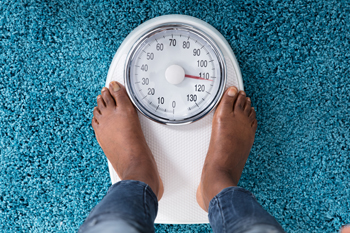 Obesity leads to increased risk for many chronic health issues. Your feet and ankles are especially susceptible to these risks because carrying extra weight puts a heavy strain on them. Ankles are weight bearing joints, so they tend to be one of the first parts of the body to experience discomfort from weight gain. Some examples of obesity related health issues that affect the ankles are weakened tendons and ligaments, increased risk of ankle sprain, and posterior tibial tendonitis. Obesity can lead to serious health complications in your feet such as, neuropathy, gout, osteoarthritis, osteoporosis and diabetes. If you are concerned for the health of your feet in relation to obesity, then it is recommended to speak with a podiatrist for additional information and treatment options.
Obesity leads to increased risk for many chronic health issues. Your feet and ankles are especially susceptible to these risks because carrying extra weight puts a heavy strain on them. Ankles are weight bearing joints, so they tend to be one of the first parts of the body to experience discomfort from weight gain. Some examples of obesity related health issues that affect the ankles are weakened tendons and ligaments, increased risk of ankle sprain, and posterior tibial tendonitis. Obesity can lead to serious health complications in your feet such as, neuropathy, gout, osteoarthritis, osteoporosis and diabetes. If you are concerned for the health of your feet in relation to obesity, then it is recommended to speak with a podiatrist for additional information and treatment options.
Obesity has become very problematic at this point in time and can have extremely negative effects on the feet. If you’re an obese individual and are concerned about your feet, contact Dr. Tupper from Coshocton Foot Health Center. Our doctor can provide the care you need to keep you pain-free and on your feet.
Obesity and Your Feet
Since your feet are what support your entire weight when standing, any additional weight can result in pain and swelling. Being overweight is one of the main contributors to foot complications.
Problems & Complications
Extra Weight – Even putting on just a few extra pounds could create serious complications for your feet. As your weight increases, your balance and body will shift, creating new stresses on your feet. This uneven weight distribution can cause pain, even while doing the simplest tasks, such as walking.
Diabetes – People who are overweight are at serious risk of developing type-2 diabetes, which has a drastic impact on the health of your feet. As you get older, your diabetes might worsen, which could lead to loss of feeling in your feet, sores, and bruises. You could also become more prone to various infections.
Plantar fasciitis – Pressure and stress that is placed on muscles, joints, and tendons can trigger plantar fasciitis, which is an inflammation of tissue that forms along the bottom of the foot.
If you have any questions please feel free to contact our office located in Coshocton, OH . We offer the newest diagnostic and treatment technologies for all your foot and ankle needs.
Toe Arthritis May Be Common
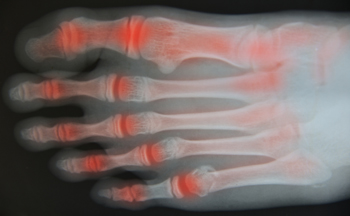 A common part of the foot where arthritis may develop is the toes. There are several joints that are located in the toes, and if inflammation should occur, arthritis may develop. This may typically cause severe pain and discomfort. There are several reasons why patients may develop toe arthritis, and these can include becoming overweight, hereditary factors, or the natural aging process. Additionally, women who choose to wear shoes that do not provide adequate room for the toes to move freely may also develop this uncomfortable foot condition. Many patients experience pain as the first symptom, and this may hinder performing everyday activities. Other symptoms may include swelling in and around the joints in the toes, possible stiffness as a result of diminished cartilage between the joints, or heat emanating from that area of the foot. If you believe you have the beginning stages of arthritis developing in your toes, speak with a podiatrist who can properly examine your condition.
A common part of the foot where arthritis may develop is the toes. There are several joints that are located in the toes, and if inflammation should occur, arthritis may develop. This may typically cause severe pain and discomfort. There are several reasons why patients may develop toe arthritis, and these can include becoming overweight, hereditary factors, or the natural aging process. Additionally, women who choose to wear shoes that do not provide adequate room for the toes to move freely may also develop this uncomfortable foot condition. Many patients experience pain as the first symptom, and this may hinder performing everyday activities. Other symptoms may include swelling in and around the joints in the toes, possible stiffness as a result of diminished cartilage between the joints, or heat emanating from that area of the foot. If you believe you have the beginning stages of arthritis developing in your toes, speak with a podiatrist who can properly examine your condition.
Arthritis can be a difficult condition to live with. If you are seeking treatment, contact Dr. Tupper from Coshocton Foot Health Center. Our doctor can provide the care you need to keep you pain-free and on your feet.
Arthritic Foot Care
Arthritis is a term that is commonly used to describe joint pain. The condition itself can occur to anyone of any age, race, or gender, and there are over 100 types of it. Nevertheless, arthritis is more commonly found in women compared to men, and it is also more prevalent in those who are overweight. The causes of arthritis vary depending on which type of arthritis you have. Osteoarthritis for example, is often caused by injury, while rheumatoid arthritis is caused by a misdirected immune system.
Symptoms
- Swelling
- Pain
- Stiffness
- Decreased Range of Motion
Arthritic symptoms range in severity, and they may come and go. Some symptoms stay the same for several years but could potentially get worse with time. Severe cases of arthritis can prevent its sufferers from performing daily activities and make walking difficult.
Risk Factors
- Occupation – Occupations requiring repetitive knee movements have been linked to osteoarthritis
- Obesity – Excess weight can contribute to osteoarthritis development
- Infection – Microbial agents can infect the joints and trigger arthritis
- Joint Injuries – Damage to joints may lead to osteoarthritis
- Age – Risk increases with age
- Gender –Most types are more common in women
- Genetics – Arthritis can be hereditary
If you suspect your arthritis is affecting your feet, it is crucial that you see a podiatrist immediately. Your doctor will be able to address your specific case and help you decide which treatment method is best for you.
If you have any questions, please feel free to contact our office located in Coshocton, OH . We offer the newest diagnostic and treatment technologies for all your foot care needs.
Heel Pain Can Be Treated!
Children and Ingrown Toenails
 If your child complains of an irritation on the side of her big toe, they may have what is known as an ingrown toenail. The typical reasons why this condition may occur can be from wearing shoes that do not fit correctly and provide inadequate room for the toes to move freely in, and toenails that are trimmed improperly. Additionally, some children may pick at their toenails, and this type of action may lead to developing ingrown toenails. Some of the uncomfortable symptoms that are associated with this condition may be tenderness around the edge of the toenail, swelling and redness. If this ailment is not treated promptly, a painful infection may occur when bacteria enters the body through small cuts in the skin. It’s important to obtain a prompt and proper diagnosis, and this can be accomplished by consulting a podiatrist who can also assist in beginning correct treatment.
If your child complains of an irritation on the side of her big toe, they may have what is known as an ingrown toenail. The typical reasons why this condition may occur can be from wearing shoes that do not fit correctly and provide inadequate room for the toes to move freely in, and toenails that are trimmed improperly. Additionally, some children may pick at their toenails, and this type of action may lead to developing ingrown toenails. Some of the uncomfortable symptoms that are associated with this condition may be tenderness around the edge of the toenail, swelling and redness. If this ailment is not treated promptly, a painful infection may occur when bacteria enters the body through small cuts in the skin. It’s important to obtain a prompt and proper diagnosis, and this can be accomplished by consulting a podiatrist who can also assist in beginning correct treatment.
Ingrown toenails may initially present themselves as a minor discomfort, but they may progress into an infection in the skin without proper treatment. For more information about ingrown toenails, contact Dr. Tupper of Coshocton Foot Health Center. Our doctor can provide the care you need to keep you pain-free and on your feet.
Ingrown Toenails
Ingrown toenails are caused when the corner or side of a toenail grows into the soft flesh surrounding it. They often result in redness, swelling, pain, and in some cases, infection. This condition typically affects the big toe and may recur if it is not treated properly.
Causes
- Improper toenail trimming
- Genetics
- Improper shoe fitting
- Injury from pedicures or nail picking
- Abnormal gait
- Poor hygiene
You are more likely to develop an ingrown toenail if you are obese, have diabetes, arthritis, or have any fungal infection in your nails. Additionally, people who have foot or toe deformities are at a higher risk of developing an ingrown toenail.
Symptoms
Some symptoms of ingrown toenails are redness, swelling, and pain. In rare cases, there may be a yellowish drainage coming from the nail.
Treatment
Ignoring an ingrown toenail can have serious complications. Infections of the nail border can progress to a deeper soft-tissue infection, which can then turn into a bone infection. You should always speak with your podiatrist if you suspect you have an ingrown toenail, especially if you have diabetes or poor circulation.
If you have any questions, please feel free to contact our office located in Coshocton, OH . We offer the newest diagnostic and treatment technologies for all your foot care needs.
Contagious Athlete’s Foot
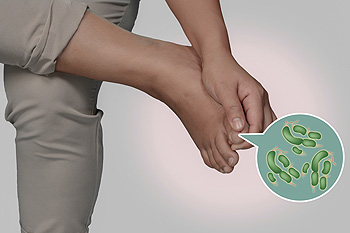 The obvious symptoms that are associated with athlete’s foot is mild to severe itching, especially between the toes. This uncomfortable condition is caused by a fungus that is known as trichophyton, and thrives in warm and moist areas, which may include the inside of shoes or socks. Additionally, this contagious fungus may live in public pools, locker rooms and surrounding areas, and it is suggested to wear appropriate shoes if you are in these places. Patients who have severe cases of athlete's’ foot may experience red, flaky, and cracked skin on the side and soles of the feet, and in extreme cases, blisters and swelling may develop. If you have become afflicted with these symptoms, it is suggested to seek the counsel of a podiatrist who can perform a correct diagnosis and proper treatment options can be discussed.
The obvious symptoms that are associated with athlete’s foot is mild to severe itching, especially between the toes. This uncomfortable condition is caused by a fungus that is known as trichophyton, and thrives in warm and moist areas, which may include the inside of shoes or socks. Additionally, this contagious fungus may live in public pools, locker rooms and surrounding areas, and it is suggested to wear appropriate shoes if you are in these places. Patients who have severe cases of athlete's’ foot may experience red, flaky, and cracked skin on the side and soles of the feet, and in extreme cases, blisters and swelling may develop. If you have become afflicted with these symptoms, it is suggested to seek the counsel of a podiatrist who can perform a correct diagnosis and proper treatment options can be discussed.
Athlete’s foot is an inconvenient condition that can be easily reduced with the proper treatment. If you have any concerns about your feet and ankles, contact Dr. Tupper from Coshocton Foot Health Center. Our doctor will treat your foot and ankle needs.
Athlete’s Foot: The Sole Story
Athlete's foot, also known as tinea pedis, can be an extremely contagious foot infection. It is commonly contracted in public changing areas and bathrooms, dormitory style living quarters, around locker rooms and public swimming pools, or anywhere your feet often come into contact with other people.
Solutions to Combat Athlete’s Foot
- Hydrate your feet by using lotion
- Exfoliate
- Buff off nails
- Use of anti-fungal products
- Examine your feet and visit your doctor if any suspicious blisters or cuts develop
Athlete’s foot can cause many irritating symptoms such as dry and flaking skin, itching, and redness. Some more severe symptoms can include bleeding and cracked skin, intense itching and burning, and even pain when walking. In the worst cases, Athlete’s foot can cause blistering as well. Speak to your podiatrist for a better understanding of the different causes of Athlete’s foot, as well as help in determining which treatment options are best for you.
If you have any questions please feel free to contact our office located in Coshocton, OH . We offer the newest diagnostic and treatment technologies for all your foot and ankle needs.
Several Ways to Treat a Broken Ankle
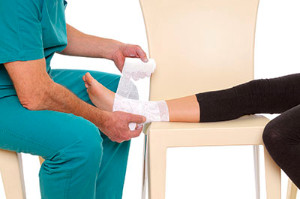 If you have fallen unexpectedly or stepped abruptly off a curb, you may have had the displeasure of experiencing an ankle sprain. It is typically the result of the ankle suddenly twisting or rolling, which may move the ankle out of alignment. There are several ligaments that surround the ankle and may tear if an ankle sprain occurs. There are several symptoms that may be associated with this condition, including noticeable swelling, bruising, and difficulty in bearing weight on the ankle. It’s important to have a proper diagnosis performed, which most likely may include having an X-ray taken. An MRI may be prescribed if the ankle sprain appears to be of a serious nature, or if damage has occurred to the surface of the ankle joint. There are many ways to treat a broken ankle, and this may depend on the severity of the injury. If you feel you have sprained your ankle, it is advised to consult with a podiatrist as quickly as possible who can determine the best course of treatment for you.
If you have fallen unexpectedly or stepped abruptly off a curb, you may have had the displeasure of experiencing an ankle sprain. It is typically the result of the ankle suddenly twisting or rolling, which may move the ankle out of alignment. There are several ligaments that surround the ankle and may tear if an ankle sprain occurs. There are several symptoms that may be associated with this condition, including noticeable swelling, bruising, and difficulty in bearing weight on the ankle. It’s important to have a proper diagnosis performed, which most likely may include having an X-ray taken. An MRI may be prescribed if the ankle sprain appears to be of a serious nature, or if damage has occurred to the surface of the ankle joint. There are many ways to treat a broken ankle, and this may depend on the severity of the injury. If you feel you have sprained your ankle, it is advised to consult with a podiatrist as quickly as possible who can determine the best course of treatment for you.
Although ankle sprains are common, they aren’t always minor injuries. If you need your ankle injury looked at, contact Dr. Tupper from Coshocton Foot Health Center. Our doctor can provide the care you need to keep you pain-free and on your feet.
How Does an Ankle Sprain Occur?
Ankle sprains are the result of a tear in the ligaments within the ankle. These injuries may happen when you make a rapid shifting movement while your foot is planted. A less common way to sprain your ankle is when your ankle rolls inward while your foot turns outward.
What Are the Symptoms?
- Pain at the sight of the tear
- Bruising/Swelling
- Ankle area is tender to touch
- In severe cases, may hear/feel something tear
- Skin discoloration
Preventing a Sprain
- Wearing appropriate shoes for the occasion
- Stretching before exercises and sports
- Knowing your limits
Treatment of a Sprain
In many cases, the RICE method (Rest, Ice, Compression, and Elevate) is used to treat ankle sprains. However, you should see a podiatrist to see which treatment option would work best with your injury. In severe cases, surgery may be required.
It is important to ask your doctor about rehab options after you receive treatment for your injury. Stretching, strength training, and balance exercises may help the ankle heal while also preventing further injury.
If you have any questions, please feel free to contact our office located in Coshocton, OH . We offer the newest diagnostic and treatment technologies for all your foot care needs.
Bunions May Lead to Additional Foot Conditions
 A bunion is described as a bony protrusion that forms on the side of the big toe. It may be unsightly and uncomfortable and is generally considered to be a deformity. Research has shown that specific bone structure, which may cause bunions to develop, may be inherited, in addition to having ailments that may include flat feet. Additionally, obesity and pregnancy may play a significant role in the formation of bunions, and this may be a result of the added weight the feet must endure. If you choose to wear shoes that do not have adequate room for the toes to move about in, a bunion may develop, which may lead to other foot conditions such as corns and calluses. If you notice a bump on the side of your big toe, it is suggested to seek the counsel of a podiatrist, so a proper diagnosis can be performed.
A bunion is described as a bony protrusion that forms on the side of the big toe. It may be unsightly and uncomfortable and is generally considered to be a deformity. Research has shown that specific bone structure, which may cause bunions to develop, may be inherited, in addition to having ailments that may include flat feet. Additionally, obesity and pregnancy may play a significant role in the formation of bunions, and this may be a result of the added weight the feet must endure. If you choose to wear shoes that do not have adequate room for the toes to move about in, a bunion may develop, which may lead to other foot conditions such as corns and calluses. If you notice a bump on the side of your big toe, it is suggested to seek the counsel of a podiatrist, so a proper diagnosis can be performed.
If you are suffering from bunions, contact Dr. Tupper of Coshocton Foot Health Center. Our doctor can provide the care you need to keep you pain-free and on your feet.
What Is a Bunion?
A bunion is formed of swollen tissue or an enlargement of boney growth, usually located at the base joint of the toe that connects to the foot. The swelling occurs due to the bones in the big toe shifting inward, which impacts the other toes of the foot. This causes the area around the base of the big toe to become inflamed and painful.
Why Do Bunions Form?
Genetics – Susceptibility to bunions are often hereditary
Stress on the feet – Poorly fitted and uncomfortable footwear that places stress on feet, such as heels, can worsen existing bunions
How Are Bunions Diagnosed?
Doctors often perform two tests – blood tests and x-rays – when trying to diagnose bunions, especially in the early stages of development. Blood tests help determine if the foot pain is being caused by something else, such as arthritis, while x-rays provide a clear picture of your bone structure to your doctor.
How Are Bunions Treated?
- Refrain from wearing heels or similar shoes that cause discomfort
- Select wider shoes that can provide more comfort and reduce pain
- Anti-inflammatory and pain management drugs
- Orthotics or foot inserts
- Surgery
If you have any questions, please feel free to contact our office located in Coshocton, OH . We offer the newest diagnostic and treatment technologies for all your foot care needs.
Reminder: When Was the Last Time...?
It Is Important to Take Care of Diabetic Feet
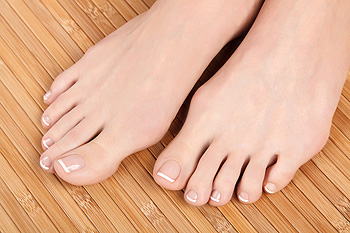 When the sugar levels in the blood become elevated, the medical condition that is known as diabetes may occur. The feet may become affected as a result of this, and proper care must be given, which may avoid uncomfortable and painful foot ailments. These may include diabetic neuropathy, which may make it difficult to feel any wounds or cuts that may be present, or peripheral vascular disease, which may limit blood flow to the feet. Research has shown that foot conditions that are associated with diabetes will benefit from effective treatment methods when implemented. These may include properly taking care of wounds or infections that may have developed, in addition to possibly wearing a boot, which may relieve pressure off the foot. If you are a diabetic patient, it is suggested that you consult with a podiatrist as quickly as possible who can properly monitor this condition, which may affect the feet.
When the sugar levels in the blood become elevated, the medical condition that is known as diabetes may occur. The feet may become affected as a result of this, and proper care must be given, which may avoid uncomfortable and painful foot ailments. These may include diabetic neuropathy, which may make it difficult to feel any wounds or cuts that may be present, or peripheral vascular disease, which may limit blood flow to the feet. Research has shown that foot conditions that are associated with diabetes will benefit from effective treatment methods when implemented. These may include properly taking care of wounds or infections that may have developed, in addition to possibly wearing a boot, which may relieve pressure off the foot. If you are a diabetic patient, it is suggested that you consult with a podiatrist as quickly as possible who can properly monitor this condition, which may affect the feet.
Diabetic foot care is important in preventing foot ailments such as ulcers. If you are suffering from diabetes or have any other concerns about your feet, contact Dr. Tupper from Coshocton Foot Health Center. Our doctor can provide the care you need to keep you pain-free and on your feet.
Diabetic Foot Care
Diabetes affects millions of people every year. The condition can damage blood vessels in many parts of the body, especially the feet. Because of this, taking care of your feet is essential if you have diabetes, and having a podiatrist help monitor your foot health is highly recommended.
The Importance of Caring for Your Feet
- Routinely inspect your feet for bruises or sores.
- Wear socks that fit your feet comfortably.
- Wear comfortable shoes that provide adequate support.
Patients with diabetes should have their doctor monitor their blood levels, as blood sugar levels play such a huge role in diabetic care. Monitoring these levels on a regular basis is highly advised.
It is always best to inform your healthcare professional of any concerns you may have regarding your feet, especially for diabetic patients. Early treatment and routine foot examinations are keys to maintaining proper health, especially because severe complications can arise if proper treatment is not applied.
If you have any questions please feel free to contact our office located in Coshocton, OH . We offer the newest diagnostic and treatment technologies for all your foot and ankle needs.
Practicing Daily Foot Care is Important
 It is important to maintain proper care for your feet, and this may be especially true of the elderly population. Research has shown the natural cushioning in the feet may diminish as the aging process occurs, and the toenails and skin may appear to become dry and brittle. There are several ways to practice good foot care, and these may include looking at your feet closely on a frequent basis, which may aid in noticing any blisters or cuts, wearing footwear that feels comfortable, and performing mild stretches, which may improve circulation. Additionally, washing and drying the feet daily may be helpful in preventing or controlling unpleasant foot odor. If you would like additional information about how to take care of elderly feet, please consult with a podiatrist.
It is important to maintain proper care for your feet, and this may be especially true of the elderly population. Research has shown the natural cushioning in the feet may diminish as the aging process occurs, and the toenails and skin may appear to become dry and brittle. There are several ways to practice good foot care, and these may include looking at your feet closely on a frequent basis, which may aid in noticing any blisters or cuts, wearing footwear that feels comfortable, and performing mild stretches, which may improve circulation. Additionally, washing and drying the feet daily may be helpful in preventing or controlling unpleasant foot odor. If you would like additional information about how to take care of elderly feet, please consult with a podiatrist.
Proper foot care is something many older adults forget to consider. If you have any concerns about your feet and ankles, contact Dr. Tupper from Coshocton Foot Health Center. Our doctor can provide the care you need to keep you pain-free and on your feet.
The Elderly and Their Feet
As we age we start to notice many changes in our body, but the elder population may not notice them right away. Medical conditions may prevent the elderly to take notice of their foot health right away. Poor vision is a lead contributor to not taking action for the elderly.
Common Conditions
- Neuropathy – can reduce feeling in the feet and can hide many life-threatening medical conditions.
- Reduced flexibility – prevents the ability of proper toenail trimming, and foot cleaning. If left untreated, it may lead to further medical issues.
- Foot sores – amongst the older population can be serious before they are discovered. Some of the problematic conditions they may face are:
- Gouging toenails affecting nearby toe
- Shoes that don’t fit properly
- Pressure sores
- Loss of circulation in legs & feet
- Edema & swelling of feet and ankles
Susceptible Infections
Diabetes and poor circulation can cause general loss of sensitivity over the years, turning a simple cut into a serious issue.
If you have any questions please feel free to contact our office located in Coshocton, OH . We offer the newest diagnostic and treatment technologies for all your foot and ankle needs.
More...
Orthotics May Help Specific Types of Foot Pain
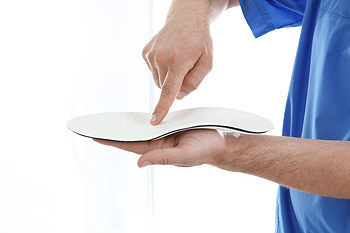 Foot pain may occur for several different reasons. Helpful aids may include wearing orthotics, which may alleviate a portion of the pain and discomfort. They are described as an insert that is placed inside the shoes and may provide the additional support and stability that is needed. There are specific kinds of orthotics that are used, and the correct type that is needed is generally determined by the type of foot pain that is experienced. Some of the conditions that are treated with these devices may include plantar fasciitis, bunions, or rheumatoid arthritis. If you have foot pain and would like additional information about the benefits of orthotics, it is suggested to consult with a podiatrist who is able to provide the answers you are seeking.
Foot pain may occur for several different reasons. Helpful aids may include wearing orthotics, which may alleviate a portion of the pain and discomfort. They are described as an insert that is placed inside the shoes and may provide the additional support and stability that is needed. There are specific kinds of orthotics that are used, and the correct type that is needed is generally determined by the type of foot pain that is experienced. Some of the conditions that are treated with these devices may include plantar fasciitis, bunions, or rheumatoid arthritis. If you have foot pain and would like additional information about the benefits of orthotics, it is suggested to consult with a podiatrist who is able to provide the answers you are seeking.
If you are having discomfort in your feet and would like to try orthotics, contact Dr. Tupper from Coshocton Foot Health Center. Our doctor can provide the care you need to keep you pain-free and on your feet.
What Are Orthotics?
Orthotics are inserts you can place into your shoes to help with a variety of foot problems such as flat feet or foot pain. Orthotics provide relief and comfort for minor foot and heel pain but can’t correct serious biomechanical problems in your feet.
Over-the-Counter Inserts
Orthotics come in a wide variety of over-the-counter inserts that are used to treat foot pain, heel pain, and minor problems. For example, arch supports can be inserted into your shoes to help correct overarched or flat feet, while gel insoles are often used because they provide comfort and relief from foot and heel pain by alleviating pressure.
Prescription Orthotics
If over-the-counter inserts don’t work for you or if you have a more severe foot concern, it is possible to have your podiatrist prescribe custom orthotics. These high-quality inserts are designed to treat problems such as abnormal motion, plantar fasciitis, and severe forms of heel pain. They can even be used to help patients suffering from diabetes by treating foot ulcers and painful calluses and are usually molded to your feet individually, which allows them to provide full support and comfort.
If you are experiencing minor to severe foot or heel pain, it’s recommended to speak with your podiatrist about the possibilities of using orthotics. A podiatrist can determine which type of orthotic is right for you and allow you to take the first steps towards being pain-free.
If you have any questions please contact our office located in Coshocton, OH . We offer the newest diagnostic and treatment technologies for all your foot and ankle needs.
Different Types of Blisters on the Feet
 A common reason why blisters form on the feet may be a result of consistent friction between the toes or on the back of the heel. A blister is typically a small area that resembles a bubble and is filled with fluid. This is the body’s natural defense mechanism to ensure the skin under the blister is protected. Research has shown there are different types of blisters that may form, including pinch blisters, which may be a result of a toe that is curled under the toe next to it, causing a blister to form in between the two toes. Additionally, interdigital blisters may be caused by an allergic reaction to an insect bite, and may lead to an infection. Patients who have eczema or athlete's foot may be familiar with the types of blisters these uncomfortable conditions may cause. If shoes that are worn do not fit correctly, blisters may form on the pinky toe or if excess rubbing exists on the back of the foot, it may cause unsightly blisters on the back of the heel. If you would like to learn about how to prevent blisters on the feet or need information about proper treatment techniques, it’s suggested to speak with a podiatrist.
A common reason why blisters form on the feet may be a result of consistent friction between the toes or on the back of the heel. A blister is typically a small area that resembles a bubble and is filled with fluid. This is the body’s natural defense mechanism to ensure the skin under the blister is protected. Research has shown there are different types of blisters that may form, including pinch blisters, which may be a result of a toe that is curled under the toe next to it, causing a blister to form in between the two toes. Additionally, interdigital blisters may be caused by an allergic reaction to an insect bite, and may lead to an infection. Patients who have eczema or athlete's foot may be familiar with the types of blisters these uncomfortable conditions may cause. If shoes that are worn do not fit correctly, blisters may form on the pinky toe or if excess rubbing exists on the back of the foot, it may cause unsightly blisters on the back of the heel. If you would like to learn about how to prevent blisters on the feet or need information about proper treatment techniques, it’s suggested to speak with a podiatrist.
Blisters may appear as a single bubble or in a cluster. They can cause a lot of pain and may be filled with pus, blood, or watery serum. If your feet are hurting, contact Dr. Tupper of Coshocton Foot Health Center. Our doctor can provide the care you need to keep you pain-free and on your feet.
Foot Blisters
Foot blisters are often the result of friction. This happens due to the constant rubbing from shoes, which can lead to pain.
What Are Foot Blisters?
A foot blister is a small fluid-filled pocket that forms on the upper-most layer of the skin. Blisters are filled with clear fluid and can lead to blood drainage or pus if the area becomes infected.
Symptoms
(Blister symptoms may vary depending on what is causing them)
- Bubble of skin filled with fluid
- Redness
- Moderate to severe pain
- Itching
Prevention & Treatment
In order to prevent blisters, you should be sure to wear comfortable shoes with socks that cushion your feet and absorb sweat. Breaking a blister open may increase your chances of developing an infection. However, if your blister breaks, you should wash the area with soap and water immediately and then apply a bandage to the affected area. If your blisters cause severe pain it is important that you call your podiatrist right away.
If you have any questions, please feel free to contact our office located in Coshocton, OH . We offer the newest diagnostic and treatment technologies for all your foot care needs.
Why Live with Pain and Numbness in Your Feet?
Symptoms Of Tarsal Tunnel Syndrome
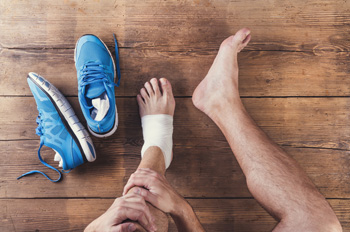 The medical condition that is referred to as tarsal tunnel syndrome typically affects the ligaments that stretch across the foot. These are known to provide flexibility and stability to the foot, and may become irritated and inflamed if they are compressed. This may occur as a result from an injury or trauma the foot endures, possibly due to performing repetitive motions. There are several symptoms that are associated with this condition. Many patients will notice a burning or tingling sensation in their foot and may also be accompanied by a shooting pain in the ankle. If you have injured your foot or have pain in the ankle that develops gradually, it’s suggested to speak with a podiatrist so a proper diagnosis can be performed, and the correct treatment can begin.
The medical condition that is referred to as tarsal tunnel syndrome typically affects the ligaments that stretch across the foot. These are known to provide flexibility and stability to the foot, and may become irritated and inflamed if they are compressed. This may occur as a result from an injury or trauma the foot endures, possibly due to performing repetitive motions. There are several symptoms that are associated with this condition. Many patients will notice a burning or tingling sensation in their foot and may also be accompanied by a shooting pain in the ankle. If you have injured your foot or have pain in the ankle that develops gradually, it’s suggested to speak with a podiatrist so a proper diagnosis can be performed, and the correct treatment can begin.
Tarsal tunnel syndrome can be very uncomfortable to live with. If you are experiencing tarsal tunnel syndrome, contact Dr. Tupper of Coshocton Foot Health Center. Our doctor can provide the care you need to keep you pain-free and on your feet.
Tarsal Tunnel Syndrome
Tarsal tunnel syndrome, which can also be called tibial nerve dysfunction, is an uncommon condition of misfiring peripheral nerves in the foot. The tibial nerve is the peripheral nerve in the leg responsible for sensation and movement of the foot and calf muscles. In tarsal tunnel syndrome, the tibial nerve is damaged, causing problems with movement and feeling in the foot of the affected leg.
Common Cause of Tarsal Tunnel Syndrome
- Involves pressure or an injury, direct pressure on the tibial nerve for an extended period of time, sometimes caused by other body structures close by or near the knee.
- Diseases that damage nerves, including diabetes, may cause tarsal tunnel syndrome.
- At times, tarsal tunnel syndrome can appear without an obvious cause in some cases.
The Effects of Tarsal Tunnel Syndrome
- Different sensations, an afflicted person may experience pain, tingling, burning or other unusual sensations in the foot of the affected leg.
- The foot muscles, toes and ankle become weaker, and curling your toes or flexing your foot can become difficult.
- If condition worsens, infections and ulcers may develop on the foot that is experiencing the syndrome.
A physical exam of the leg can help identify the presence of tarsal tunnel syndrome. Medical tests, such as a nerve biopsy, are also used to diagnose the condition. Patients may receive physical therapy and prescriptive medication. In extreme cases, some may require surgery.
If you have any questions please feel free to contact our office located in Coshocton, OH . We offer the newest diagnostic and treatment technologies for all your foot and ankle needs.



